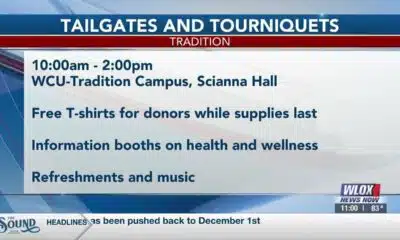Planning for retirement should be a lifelong endeavor that begins the moment you start earning enough income to sock some of it away. The earlier you start the better as compound interest and capital gains investments generate more profit when they have a longer time to accrue.
Planning your life after 65 might include finding a new place to call home. Ideally, such a place would offer important amenities such as easy access to physical activities, quality health care, and social venues. (Affordability is important too, and Hawaii is the most expensive state to retire in.)
Based on an index of 11 key measures – including health outcomes, the concentration of medical service providers, air quality, and venues for physical activity and entertainment – Franklin County ranks as the best place to retire in Mississippi. Home to the town of Meadville, Franklin County has a population of 7,705 people, 20.1% of whom are retirement age.
One reason the county stands out among other parts of the state is the concentration of places for physical activity. An estimated 70.1% of the county population live in close proximity to places like parks, gyms, and recreation centers, compared to just 57.5% of the state’s population as a whole.
Click here to see a full explanation of 11 measures used to determine the best place to retire in every state. Only counties or county equivalents where the share of the population who are 65 or older exceeds the 16% national share were considered.
| Best place to retire | Total population | Retirement age residents as share of total pop. (%) | Avg. life expectancy at birth (years) | Pop. with access to locations for physical activity (%) | Primary care physicians per 100,000 people |
|---|---|---|---|---|---|
| Alabama: Baldwin County | 227,131 | 20.6 | 77.7 | 65.7 | 62.7 |
| Alaska: Haines Borough | 2,098 | 20.9 | 84.4 | 96.8 | 289.7 |
| Arizona: Yavapai County | 233,789 | 31.9 | 78.4 | 85.0 | 57.4 |
| Arkansas: Montgomery County | 8,525 | 26.8 | 75.1 | 97.2 | 23.2 |
| California: Marin County | 262,387 | 22.4 | 85.2 | 97.5 | 144.9 |
| Colorado: Pitkin County | 17,471 | 19.3 | 92.5 | 94.6 | 86.5 |
| Connecticut: Middlesex County | 164,568 | 20.5 | 80.8 | 97.3 | 78.3 |
| Delaware: Sussex County | 234,045 | 28.3 | 78.4 | 65.0 | 57.8 |
| Florida: Sumter County | 127,335 | 57.6 | 80.2 | 88.8 | 39.8 |
| Georgia: Towns County | 12,300 | 33.7 | 79.0 | 100.0 | 54.4 |
| Hawaii: Kauai County | 73,247 | 20.3 | 82.3 | 91.8 | 81.7 |
| Idaho: Blaine County | 23,868 | 19.1 | 85.2 | 74.5 | 88.8 |
| Illinois: Monroe County | 34,732 | 17.7 | 80.7 | 85.6 | 37.2 |
| Indiana: Dubois County | 43,474 | 17.3 | 79.2 | 75.5 | 78.1 |
| Iowa: Dickinson County | 17,536 | 25.9 | 80.7 | 84.2 | 72.8 |
| Kansas: Gove County | 2,774 | 24.8 | 80.2 | 42.9 | 217.8 |
| Kentucky: Woodford County | 26,758 | 18.5 | 77.6 | 83.0 | 66.5 |
| Louisiana: Jefferson Parish | 439,402 | 17.3 | 76.7 | 96.3 | 97.8 |
| Maine: Hancock County | 55,417 | 25.1 | 79.5 | 66.4 | 115.7 |
| Maryland: Talbot County | 37,510 | 29.1 | 79.3 | 71.6 | 103.7 |
| Massachusetts: Dukes County | 20,277 | 24.0 | 81.3 | 96.7 | 66.4 |
| Michigan: Emmet County | 33,946 | 22.5 | 79.3 | 82.4 | 119.8 |
| Minnesota: Cook County | 5,574 | 28.5 | 82.5 | 83.8 | 142.4 |
| Mississippi: Franklin County | 7,705 | 20.1 | 74.4 | 70.1 | 26.1 |
| Missouri: St. Louis County | 1,001,982 | 18.0 | 77.2 | 95.4 | 126.5 |
| Montana: Park County | 17,072 | 23.0 | 79.9 | 75.4 | 114.5 |
| Nebraska: Brown County | 2,752 | 28.1 | 79.1 | 79.6 | 103.2 |
| Nevada: Douglas County | 49,158 | 29.0 | 81.1 | 80.9 | 52.1 |
| New Hampshire: Grafton County | 91,025 | 20.8 | 80.7 | 84.9 | 187.6 |
| New Jersey: Morris County | 508,347 | 17.0 | 81.8 | 98.5 | 97.1 |
| New Mexico: Los Alamos County | 19,169 | 17.4 | 83.9 | 99.3 | 150.0 |
| New York: New York County | 1,669,127 | 16.8 | 83.7 | 100.0 | 142.2 |
| North Carolina: Transylvania County | 32,979 | 30.1 | 81.0 | 85.0 | 72.4 |
| North Dakota: Mercer County | 8,405 | 20.0 | 81.9 | 79.1 | 84.1 |
| Ohio: Medina County | 181,448 | 18.0 | 79.9 | 92.7 | 62.8 |
| Oklahoma: Ellis County | 3,813 | 23.2 | 76.2 | 37.1 | 53.2 |
| Oregon: Wallowa County | 7,330 | 29.3 | 82.0 | 58.5 | 145.8 |
| Pennsylvania: Montgomery County | 850,890 | 17.7 | 80.5 | 96.4 | 132.8 |
| Rhode Island: Bristol County | 50,672 | 19.7 | 81.2 | 99.5 | 192.8 |
| South Carolina: Beaufort County | 186,007 | 27.4 | 82.6 | 86.0 | 71.4 |
| South Dakota: Fall River County | 6,979 | 29.9 | 74.7 | 86.4 | 69.4 |
| Tennessee: Johnson County | 17,912 | 22.8 | 74.0 | 100.0 | 33.0 |
| Texas: Jeff Davis County | 2,021 | 36.9 | 84.4 | 44.3 | 51.3 |
| Utah: Grand County | 9,630 | 20.4 | 79.4 | 94.5 | 134.5 |
| Vermont: Washington County | 59,609 | 19.7 | 79.8 | 73.4 | 100.1 |
| Virginia: James City County | 77,733 | 25.2 | 81.6 | 97.5 | 111.4 |
| Washington: San Juan County | 17,631 | 33.7 | 86.3 | 86.2 | 70.1 |
| West Virginia: Tucker County | 6,822 | 26.3 | 75.5 | 98.7 | 60.0 |
| Wisconsin: Ozaukee County | 91,029 | 19.8 | 81.9 | 97.3 | 141.6 |
| Wyoming: Park County | 29,664 | 23.3 | 80.5 | 72.5 | 122.9 |














































